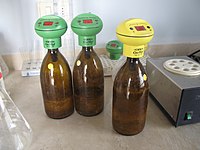
Photo from wikipedia
Abstract A metabolically versatile and highly efficient 4-Nitrophenol degrading bacterial consortium was isolated from a pesticide-contaminated agricultural soil by successive enrichment on a mineral salt medium. Based on the phylogenetic… Click to show full abstract
Abstract A metabolically versatile and highly efficient 4-Nitrophenol degrading bacterial consortium was isolated from a pesticide-contaminated agricultural soil by successive enrichment on a mineral salt medium. Based on the phylogenetic analysis, the members of the consortium were found to be Brevibacterium sp. PNP1 (MH169212), Pseudomonas sp. PNP2 (MH169213), Agromyces mediolanus PNP3 (MH169214) and Microbacterium oxydans PNP4 (MH169215). Taguchi Design of experiments approach (DOE) was applied using Qualitek-4 software for the optimization of parameters to enhance the biomass growth and 4-Nitrophenol biodegradation efficiency. Nine physicochemical parameters such as magnesium sulphate, phosphate ion, yeast extract, calcium chloride, temperature, pH, inoculum dose, incubation time, and agitation speed were chosen for optimization due to their crucial impact on biomass growth and 4-Nitrophenol degradation. 27 trials of biodegradation experiments were performed under the L-27 Orthogonal Array (OA) designed by the Taguchi approach. The experimental data were analyzed using the Signal-to-noise (S/N) ratio with the 'bigger is better' characteristics to identify the influential parameters and to establish the optimum conditions for maximizing 4-Nitrophenol biodegradation. Validation of the predicted data with the confirmatory experiments revealed that 1.19 g/L of biomass and 99.12% of 4-Nitrophenol degradation could be attained resulting in 121.48% and 249.88% enhancement in the biomass growth and 4-Nitrophenol degradation respectively, at the optimized condition of yeast extract 2.0 g/L, pH 9.5, temperature 32 °C, incubation time 78 h, agitation 160 rpm, and inoculum dose 0.5 absorbance units (AU) of OD600.
Journal Title: Journal of environmental chemical engineering
Year Published: 2020
Link to full text (if available)
Share on Social Media: Sign Up to like & get
recommendations!